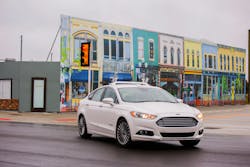For Testing Autonomous Cars, Engineers Resort to Signals and Simulations
Gill Pratt, chief of the Toyota Research Institute, told the U.S. Committee on Energy and Commerce in March that self-driving cars would require billions of miles of testing. But not every mile would be on actual roads.
To save the time and money needed for testing, companies have increasingly turned to so-called hardware-in-the-loop (HIL) equipment for testing automotive parts like cameras and radar, as well as virtual driving software to validate electronic control units for collision avoidance and other advanced safety systems.
With HIL systems, engineers can send electrical pulses into radar systems, for instance, as if they had been reflected from cars and other objects. The signals can also be injected into ignition, braking, and infotainment throughout the design and production process, allowing an endless number of tests on what breaks the system.
The automotive industry has used HIL for decades, but the tests have taken off with the growing complexity of advanced safety systems, experts said at National Instruments’ NI Week conference last week. Paired with virtual driving software, engineers can test collision avoidance and automatic braking functions for millions of miles without stepping foot in a vehicle.
“It’s like taking and replaying a video,” said Sam Dieck, a staff digital hardware engineer at National Instruments, which sells prototyping machines as well as software tools under the brand Veristand for acquiring signals from automotive parts and testing the parts with HIL systems.
These tests are increasingly vital, experts said. The flow of information inside vehicles is growing more complex. For instance, a front-facing camera will pool data with other sensors like radar to improve collision avoidance systems, while other sensors will convey engine diagnostics to the car’s dashboard display.
These systems are also constantly changing, said Derek O’Dea, measurement equipment and tools development manager at automotive supplier Valeo. To develop an automatic braking system, the company injects data from actual road tests into HIL equipment, where engineers can refine the code before pumping it into an electronic control unit.
Much of that code can be saved for later. HIL testing lets Valeo reuse around four-fifths of the code in future systems, O'Dea said
But many companies have started using more than just signals. IPG Automotive, which sells virtual driving software, says it has licensing deals with every major automotive equipment maker. Waymo, the autonomous carmaker that split off from Google, said in a January report that its software can simulate more than 3 million miles of driving each day.
In computer simulations, entire vehicles can be studied without incurring the costs or exposing drivers to the dangers of road testing. "We have all these components embedded in a virtual prototype, so we can test the entire system [over and over again],” said Raphael Pfeffer, IPG's product manager for test systems, in an NI Week presentation.
IPG’s Carmaker software looks like a video game, but it comes with virtual hazards not only risky for actual road testing but also extremely tricky for self-driving cars. These include crosswalks clogged with pedestrians, multiple cars running red lights at a four-way intersection, people using wheelchairs or walkers, or joggers jumping into the road.
With IPG’s prototyping tools, developers can deploy these virtual tests at will. The software, which can model all the components inside cars, trucks, and motorcycles as well as drivers, is also compatible with three-dimensional maps from companies like Here, allowing engineers to test how vehicles navigate actual locales.
Other simulators aim for full immersion. Last year, researchers opened a simulator at the University of Warwick in England to house an actual vehicle, where physical prototypes can be tested without hitting the road. A screen completely surrounds the vehicle, projecting 30 miles of virtual road built from images of the nearby city of Coventry, said Gunwant Dhadyalla, a principal engineer at the University of Warwick.
The vehicle contains actuators to simulate acceleration, braking, or stumbling into a pothole. Earlier this year, Paul Jennings, head of experimental engineering at Warwick, told The Economist that the machine could simulate hundreds of sunrises and sunsets in a single day to improve antiglare cameras too dangerous to test in safety systems on public roads.
“There is no good way to inject errors into safety systems while you are on the road,” said Michael Konrad, chief executive of test system designer Konrad Technologies, which has partnered with other hardware-in-the-loop firms to devise virtual tests that run the gamut of advanced driver assist systems, from vehicle communications to sensor fusion.
Many researchers have turned to actual video games to test decision-making algorithms. Last year, researchers from Intel Labs started writing self-driving code for the cars in Grand Theft Auto 5, putting a vehicle through its paces with the traffic, pedestrians, rain, and other obstacles in the fictional city of Los Santos.
Though hardware-in-the-loop equipment can inject erroneous signals into devices and virtual driving software can throw lots of complexity at self-driving cars, both types of testing can only do so much. The open road provides the most realistic data, but “putting someone in an actual car should be the last line of testing,” said Quentin Smith, an applications engineer at National Instruments.
“It’s obvious we can’t do this without simulation,” said IPG Automotive’s Pfeffer.
About the Author
James Morra
Senior Editor
James Morra is the senior editor for Electronic Design, covering the semiconductor industry and new technology trends, with a focus on power electronics and power management. He also reports on the business behind electrical engineering, including the electronics supply chain. He joined Electronic Design in 2015 and is based in Chicago, Illinois.

